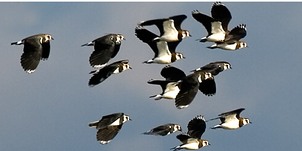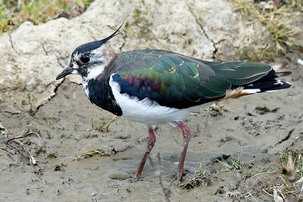

Biodiversity
Action
Plan

Floodplain Grazing Marsh: Features
Floodplain Grazing Marsh’s wet and damp grassland, ditches and subsistence flashes, scrapes and water-filled areas, and muddy and marshy areas, all promote biodiversity.
Extensive but shallow flooding in the winter, added to existing standing water, creates ideal conditions for over-wintering wildfowl and waders, and some passage species.
Varied depths of water with remaining grassland provide opportunities for diving, dabbling, wading, and grazing species like Wigeon.
There are important populations of wintering Wigeon as well as Teal, Lapwing and Golden Plover.
There can be high numbers of breeding Lapwing. Other waders include: Redshank, Common Snipe, Ringed Plover and Little Ringed Plover. Breeding Avocet numbers are increasing.
Kestrel and Barn Owl hunt for prey over Grazing Marsh as well.
Mammals. Brown Hare. Several bat species also use them for foraging.
Voles, mice and shrews are found and Water Vole have frequented the ditches.
Reptiles / Amphibians. Grass Snake, Great Crested Newt, other newts.
Fish. Eel.
Invertebrates. A range of invertebrates including a number of rare snails as well as dragon and damselflies in the water bodies
Plants. Grazing Marsh grassland is generally species-poor, but Great Burnet, Pepper Saxifrage and Marsh Marigold may be found. Specialised plants may occur in water-filled ditches on Grazing Marsh.
The water bodies dissecting and bordering the grassland can be important themselves for a number of plants and invertebrates including a number of rare snails as well as dragon and damselflies. They are also valuable for amphibians, for Grass Snakes that feed on them and for Eels. Water Voles have been known to frequent them.
Marginal vegetation around ditches and other water bodies can be rich in plants species and is very valuable for invertebrates.
A succession of wet muddy margins and marshy grassland drawn down as flooded areas recede in the Spring and Summer are important for breeding wildfowl, waders and their chicks to feed in. The large number of invertebrates present in the soft damp soils and shallow water provide important food for adults and their chicks.
Tussocky, damp grassland swards provide good habitat for foraging and breeding waders. Lapwings prefer short grazed swards and Snipe like a more varied sward height as do Redshank. Avocets, Ringed Plover and Little Ringed Plover nest in shallow scrapes on mud, gravel or sparse vegetation in the Dearne Valley wetlands.
Grazing marsh species
Birds. Grazing marshes are of major significance for breeding, passage and wintering birds.



Floodplain grazing marsh features
